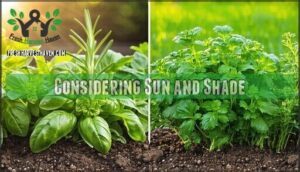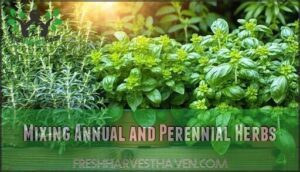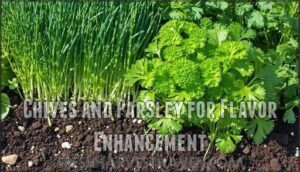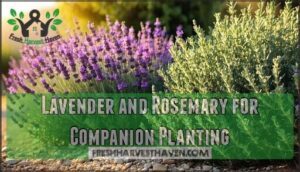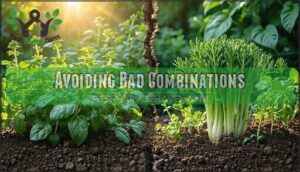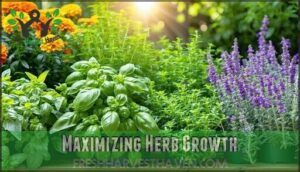This site is supported by our readers. We may earn a commission, at no cost to you, if you purchase through links.
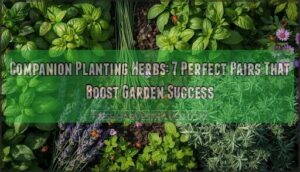
You’ll pair herbs based on their complementary needs—some repel pests while others attract beneficial insects, and certain combinations enhance soil nutrients or provide wind protection.
Popular pairings include basil with oregano for pest control, chives with parsley for flavor enhancement, and lavender with rosemary for aromatic benefits.
However, avoid problematic combinations like fennel with most herbs or mint near delicate plants, as these can inhibit growth.
Smart spacing considers mature plant sizes, sun requirements, and whether herbs are annual or perennial.
The right combinations turn your herb garden into a self-supporting ecosystem that produces healthier, more flavorful harvests with less maintenance.
Table Of Contents
- Key Takeaways
- Choosing Herb Companions
- Herb Garden Layouts
- Popular Herb Profiles
- Avoiding Bad Combinations
- Maximizing Herb Growth
- Frequently Asked Questions (FAQs)
- Which herbs should not be planted together?
- What herbs grow well together chart?
- What herbs can be planted next to one another?
- What is the best layout for an herb garden?
- What herbs should not be planted next to each other?
- What herbs Cannot be together?
- What herbs pair well together?
- What is companion planting with herbs?
- Do companion herbs attract pests?
- What is a companion plant?
- Conclusion
Key Takeaways
- Pair compatible herbs strategically – Plant basil with oregano, chives with parsley, and lavender with rosemary for natural pest control and enhanced growth benefits.
- Avoid problematic combinations – Do not plant fennel with most herbs, keep mint contained to prevent aggressive spreading, and separate herbs with conflicting water needs, like basil and sage.
- Design your layout based on plant requirements – Group herbs by sun exposure needs, consider mature plant sizes for proper spacing, and mix annuals with perennials for year-round garden structure.
- Create a self-sustaining ecosystem – Strategic companion planting can increase yields by 30% while reducing pest damage by 50% through natural partnerships that improve soil health and attract beneficial insects.
Choosing Herb Companions
When you’re choosing herb companions for your garden, you’ll want to pair plants that support each other’s growth while avoiding combinations that compete for resources or stunt development.
The right herb partnerships can naturally repel pests, improve soil conditions, and maximize your harvest space through strategic placement and complementary growing habits, using complete concepts and strategic placement to achieve this.
Benefits of Companion Planting
Companion planting herbs creates natural partnerships that deliver remarkable benefits for your garden.
You’ll experience pest reduction as aromatic herbs repel unwanted insects, while growth enhancement occurs through improved nutrient uptake.
Soil improvement happens when deep-rooted herbs break up compacted earth.
Flavor synergy develops between compatible plants, and space optimization maximizes your garden’s productivity through strategic placement.
Compatible Herb Pairings
Creating successful herb garden companion pairings requires understanding how different plants work together.
The best herbs to plant together share similar growing needs while offering mutual benefits.
Perfect companion planting herbs combinations include:
- Basil and oregano – Compatible growth habits with basil’s upright form complementing oregano’s spreading nature
- Rosemary and thyme – Both require full sun and well-drained soil, creating excellent growth synergy
- Chives and parsley – Thrive in moist conditions while chives provide natural pest deterrents
- Sage and thyme – Drought-tolerant perennials that return year after year with minimal nutrient competition
- Mint and lemon balm – Share container space effectively due to similar aromatic influence and water needs
These herb garden companion combinations maximize space while enhancing flavor profiles through strategic placement.
For example, planting tomatoes with basil is a great way to achieve natural pest deterrence.
Incompatible Herb Combinations
While some herbs thrive together, certain combinations create growth inhibition and nutrient competition that devastate your herb garden companion plants.
Fennel releases allelopathic effects that stunt most herbs, while cilantro suppresses tarragon’s flavor.
Basil and sage clash over moisture needs, causing one to fail, and exhibit incompatible soil needs, as seen with rosemary and basil, which can be found at incompatible soil needs.
Peppermint’s aggressive spread chokes parsley, and dill cross-pollinates with related herbs, altering taste profiles completely.
Herb Garden Layouts
Smart herb garden layouts maximize growth by grouping plants with similar needs while leveraging beneficial partnerships.
You’ll create thriving combinations when you match sun-loving Mediterranean herbs like rosemary and thyme in bright spots, while placing shade-tolerant parsley and chives in cooler areas to achieve maximize growth.
Designing for Maximum Growth
Why struggle with cramped herb gardens when strategic design maximizes every inch? Proper herb garden design with companion plants herbs creates thriving ecosystems that boost yields naturally.
- Optimal Spacing – Allow 12-18 inches between mature herbs
- Vertical Gardening – Stack trailing herbs above compact varieties
- Soil Amendments – Mix compost for nutrient-rich growing conditions
- Watering Techniques – Group herbs by moisture needs together
- Sunlight Exposure – Position tall herbs behind shorter companions
Consider using vertical planting systems to maximize space.
Considering Sun and Shade
Light exposure determines your herbs’ success.
Position sun-loving basil, rosemary, and oregano in areas receiving 6-8 hours of direct sunlight for maximum growth.
Shade-tolerant herbs like parsley, chives, and cilantro thrive with 3-4 hours of morning light.
Strategic herb placement based on sunlight requirements maximizes your organic gardening herbs potential while ensuring proper companion plants herbs development throughout your garden.
Mixing Annual and Perennial Herbs
When planning herbs for vegetable garden success, balance annual and perennial varieties for Garden Longevity.
Place perennials like rosemary and thyme in permanent spots, considering their Root Depths and mature size.
Annual herbs such as basil fill gaps between established plants.
Understanding Herb Lifecycles helps you anticipate Seasonal Needs and Growth Habits, creating sustainable companion planting layouts.
Consider raised garden beds for improved drainage and accessibility.
Popular Herb Profiles
Now you’ll discover which herb combinations work best together and why these partnerships create thriving gardens.
These proven pairings offer natural pest control, enhanced flavors, and improved growing conditions for your entire herb collection.
Basil and Oregano for Pest Control
Basil pests like aphids and mosquitoes can’t stand the aromatic defense these two powerhouse herbs create together.
Oregano benefits include repelling cabbage worms and spider mites, while basil’s eugenol compounds deter fruit flies and tomato hornworms.
This companion efficacy works through natural repellents that mask host plant scents, confusing pests searching for food sources in your herbs for vegetable garden setup, utilizing the herbs’ aromatic defense.
Chives and Parsley for Flavor Enhancement
Chives and parsley make exceptional companions, sharing similar growing conditions while offering complementary flavor profiles for your culinary pairings.
These herbs thrive together in well-drained soil with consistent moisture, creating natural pest resistance through their combined aromatic compounds.
Their nutrient needs align perfectly, allowing efficient space usage in any herbs companion planting guide.
This organic gardening herbs combination delivers benefits of companion planting through enhanced flavors and garden health, with natural pest resistance and efficient space usage.
Lavender and Rosemary for Companion Planting
Through Mediterranean gardens, lavender and rosemary create the perfect partnership for your herbs companion planting guide.
These aromatic powerhouses share identical water needs and soil preferences, simplifying maintenance while delivering impressive pest repellency against aphids and moths.
Their combined aromatic benefits enhance any organic gardening herbs setup, while lavender’s companion flowers attract beneficial pollinators that boost garden health naturally.
This pairing also benefits from similar light requirements, which is a key factor in their companion planting success, making them a great choice for a herbs companion planting guide.
Sage and Thyme for Soil Health
You’ll discover these Mediterranean powerhouses work brilliantly together, creating a natural partnership that transforms your garden’s foundation.
Sage benefits include deep root systems that prevent erosion, while thyme benefits feature dense ground coverage that stabilizes topsoil.
This companion planting duo enhances soil microbes and improves nutrient cycling, making them essential herbs for healthy garden ecosystems.
Avoiding Bad Combinations
Not all herbs play well together, and some combinations can actually harm your garden’s success.
You’ll want to avoid pairing fennel with most other herbs, keeping cilantro away from tarragon, separating basil from sage.
Never planting peppermint next to parsley is also crucial to your garden’s health.
Fennel and Most Herbs
Fennel’s impact on herb growth makes it the garden’s troublemaker. This aromatic herb releases chemicals that stunt most companion herbs vegetables, destroying the benefits of companion planting through aggressive allelopathic effects.
Fennel’s notorious reputation as a garden bully is well-earned—this herb sabotages nearly every companion.
Fennel disrupts garden design by:
- Inhibiting germination of neighboring herbs that grow together
- Reducing seedling growth by over 80% in companion benefits testing
- Competing aggressively for nutrients with its extensive root system
- Cross-pollinating with dill, weakening both plants’ aromatic qualities
Plant fennel separately or use containers to protect your companion planting chart success. For grilling purposes, however, consider that fennel pairs well with garlic chives, which can enhance the aromatic qualities and create a unique flavor profile with aggressive allelopathic effects.
Cilantro and Tarragon
Cilantro and tarragon make poor garden companions due to conflicting growing conditions and flavor profiles.
Cilantro varieties thrive in consistently moist soil, while tarragon uses well-drained conditions.
Their different water needs create care challenges when growing herbs together.
Cilantro’s fast growth can overshadow slower tarragon, disrupting companion herbs vegetables balance.
Their distinct culinary pairings and flavor profiles don’t complement each other well in cooking either, which affects the overall culinary pairings.
Basil and Sage
Though both aromatic, basil and sage make terrible garden neighbors due to conflicting growing conditions.
Basil craves consistent moisture and rich, fertile soil, while sage thrives in well-drained, sandy conditions with minimal water.
When you’re growing herbs together, these mismatched needs create a watering dilemma that stunts both plants’ growth and reduces harvests substantially, leading to a significant impact on the overall health of the plants, particularly affecting their ability to thrive in well-drained environments.
Peppermint and Parsley
Peppermint’s aggressive spreading habit makes it a poor companion for delicate parsley.
While both mint varieties and parsley types offer distinct flavor profiles and culinary uses, their growing conditions clash dramatically.
Peppermint’s invasive roots quickly overwhelm parsley’s shallow root system, stealing nutrients and space.
This combination defeats natural pest control benefits and companion planting advantages, leaving your parsley struggling to survive, which is why natural pest control and companion planting are important considerations.
Maximizing Herb Growth
You’ll achieve the best herb garden results when you understand each plant’s growth requirements and plan accordingly.
Strategic placement based on size, growth habits, and environmental needs creates ideal conditions for all your herbs to thrive together, which is crucial for a successful herb garden with complete concepts in mind.
Knowing Final Herb Size
You’ll want to research mature herb dimensions before planting since growth habits vary dramatically.
Basil might reach 18 inches tall while oregano stays compact at 6 inches.
Check spacing requirements and root depth for each variety.
Proper container size prevents overcrowding, ensuring your herbs for tomatoes and peppers get adequate nutrients.
Understanding final size helps maximize natural pest control herbs’ effectiveness through strategic placement, using herbs like basil.
Identifying Annual or Perennial
Knowing whether your herbs are annual or perennial helps you plan companion plantings effectively.
Annual herbs like basil, cilantro, and dill complete their lifecycle in one season, requiring replanting each year.
Perennial herbs such as rosemary, thyme, and oregano return annually, establishing permanent garden anchors.
Understanding these Annual Herb Lifecycles and Perennial Herb Growth patterns guarantees you pair plants with similar seasonal needs and propagation requirements, which is crucial for effective planning.
Mixing Shade and Sun Plants
Strategic plant placement balances light requirements and water needs effectively.
Position sun-loving herbs like rosemary and thyme in bright spots, while shade-tolerant parsley and chives thrive in filtered light.
Understanding growth habits helps prevent overcrowding.
Match soil moisture preferences between neighboring plants to simplify maintenance and maximize companion planting benefits.
Planting for Pest Control and Flavor
Smart herb combinations create natural pesticides while enhancing flavor pairings.
Nature’s teamwork beats any pesticide—herbs protect and flavor each other perfectly.
Plant aromatic herbs like basil near tomatoes to repel aphids and boost taste. Chives alongside carrots deter carrot flies while improving growth.
These repellent plants attract beneficial insects that control harmful pests naturally. Strategic herbs for peppers include oregano, while cabbage benefits from thyme’s protective properties.
Gardeners can also implement cultural control methods to further minimize pest issues.
Maintaining Soil Health and Preventing Disease
Healthy soil microbes thrive when you rotate herb plantings annually, preventing disease buildup in the same spots.
Add organic matter like compost to boost nutrient cycling and water retention.
Plant disease-resistant varieties together—basil near tomatoes naturally suppresses harmful pathogens.
Consider using quality compost soil for ideal growth, maintaining soil health while reducing chemical interventions with a simple approach that includes organic matter.
Frequently Asked Questions (FAQs)
Which herbs should not be planted together?
You shouldn’t plant mint with basil, fennel with most herbs, or sage with cucumber. These combinations compete for nutrients, stunt growth, or create incompatible growing conditions that harm plant development.
What herbs grow well together chart?
You’ll find basil thrives alongside tomatoes, oregano pairs perfectly with peppers, and rosemary complements sage beautifully.
Cilantro grows well with parsley, while thyme and lavender make excellent neighbors for Mediterranean gardens.
What herbs can be planted next to one another?
You’ll find success pairing basil with tomatoes, oregano with thyme, and rosemary with sage. Mint spreads aggressively, so plant it separately. Chives complement most herbs perfectly.
What is the best layout for an herb garden?
Design your herb garden in accessible blocks with tall herbs like rosemary at the back, medium ones like basil in the middle, and low-growing thyme in front.
Group compatible companions together for ideal growth.
What herbs should not be planted next to each other?
Ironically, while herbs seem naturally compatible, you shouldn’t plant fennel near most herbs—it inhibits growth.
Keep mint contained since it’ll overtake neighbors.
Separate dill from carrots and tomatoes, and avoid planting sage near cucumber.
What herbs Cannot be together?
You shouldn’t plant fennel with most herbs, especially dill, as they cross-pollinate and create bitter flavors.
Mint spreads aggressively and overwhelms neighboring plants.
Keep rosemary away from basil since they need different watering schedules and growing conditions.
What herbs pair well together?
Looking at herb pairings, you’ll discover nature’s perfect partnerships.
Basil and tomatoes create culinary magic, while oregano and thyme thrive together.
Rosemary pairs beautifully with sage, and parsley complements chives perfectly for enhanced growth, showcasing complete concepts in herb pairing.
What is companion planting with herbs?
Companion planting strategically groups herbs together to create mutually beneficial relationships.
You’ll place complementary herbs nearby so they naturally repel pests, attract beneficial insects, improve soil conditions, or enhance each other’s growth and flavor profiles.
Do companion herbs attract pests?
Most companion herbs actually repel pests rather than attract them.
You’ll find that basil deters flies and mosquitoes, while mint keeps ants away.
However, some flowering herbs like dill can attract beneficial insects that help control harmful pests.
What is a companion plant?
Studies show 80% of home gardeners use companion planting.
You’re basically creating plant partnerships where different species benefit each other.
Companion plants can repel pests, improve soil nutrients, provide shade, or attract beneficial insects, creating a natural support system for your garden.
Conclusion
Studies show that companion planting herbs can increase yields by up to 30% while reducing pest damage by 50%.
Your success with companion planting herbs depends on understanding which combinations work together and which compete for resources. Pair complementary herbs like basil with oregano or chives with parsley to create natural pest control and enhanced growth.
Avoid problematic matches such as fennel with most herbs or mint near delicate plants. Plan your garden layout considering sun requirements, mature plant sizes, and growth patterns.
These strategic partnerships transform your herb garden into a thriving, self-sustaining ecosystem by creating a natural balance that promotes healthy growth, and understanding the importance of complete concepts in gardening.
- https://www.marthastewart.com/8379510/companion-planting-guide
- https://www.almanac.com/content/companion-planting-herbs
- https://gardencenterohio.com/herbs-2/companion-planting/
- https://www.quora.com/Which-herbs-can-be-planted-together-and-how-far-apart-should-they-be-planted-or-can-they-planted-close-together
- https://extension.umn.edu/preserving-and-preparing/how-make-your-own-sauerkraut


